In the vibrant ecosystems of Florida, falcons play a pivotal role as formidable predators, contributing to the region’s ecological balance.
Florida hosts various falcon species, each adapted to its unique habitat within the state’s diverse landscapes.
From the iconic Peregrine Falcon with its breathtaking aerial acrobatics to the elusive Merlin Falcon navigating the wetlands, these birds of prey are integral to the Sunshine State’s intricate food web.
Falcons in Florida demonstrate remarkable adaptability, thriving in coastal areas, forests, and urban environments alike.
This introduction sets the stage for a closer exploration of these majestic raptors, delving into their behaviors, habitats, and conservation challenges within Florida’s dynamic and ever-changing ecosystems.
Why There Is Not So Many Species of Falcons in Florida?
Despite its rich biodiversity, Florida does not host an extensive variety of falcon species due to its unique ecological characteristics. As specialized predators, Falcons are influenced by habitat preferences, prey availability, and competition with other raptors.
Habitat Specialization
Falcons are often specialized in their habitat preferences. Florida’s ecosystems, while diverse, may not provide ideal conditions for a wide variety of falcon species.
Competition with Other Raptors
Florida is home to various other raptors, including hawks, eagles, and owls. Interspecies competition for resources, such as nesting sites and prey, may limit the number of falcon species that can coexist.
Climate Influence
Some falcon species are adapted to specific climates and may not find the subtropical climate of Florida suitable for their needs. The temperature, humidity, and seasonal variations could restrict the range of falcons in the state.
Availability of Prey
Falcons are predators that rely on specific prey types. The availability and abundance of suitable prey in Florida may vary, influencing the diversity of falcon species present.
Migration Patterns
Some falcon species are migratory and may only pass through Florida during specific seasons. This could contribute to a perceived lower diversity of falcons during certain times of the year.
Human Impact
Urbanization, habitat loss, and human activities can negatively impact falcon populations. Florida’s increasing human development may limit suitable habitats for falcons and contribute to fewer species.
Conservation Efforts
Conservation initiatives and efforts to protect certain falcon species may influence their populations in Florida. Focused conservation projects may benefit specific species but may not necessarily increase overall falcon diversity.
Isolation
Florida’s geographical isolation may limit the natural influx of new falcon species to the region, impacting the overall diversity observed in the state.
Common Characteristics of Falcons in Florida
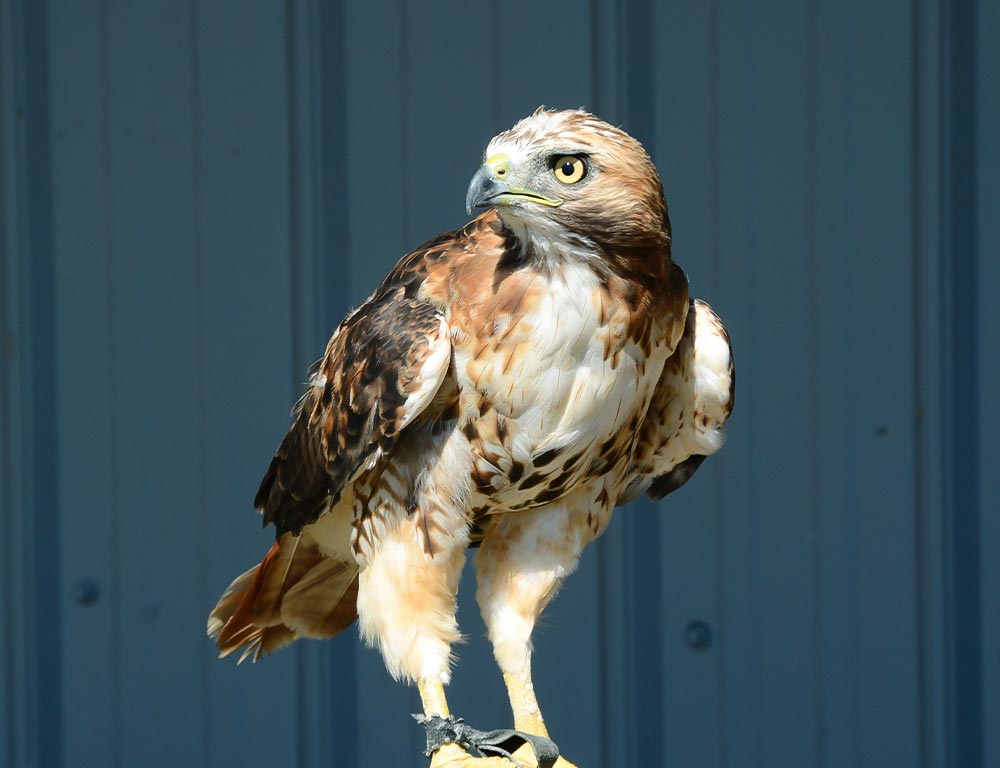
Falcons in Florida exhibit a fascinating array of characteristics that define their adaptation to the state’s diverse ecosystems.
While the number of falcon species may not be extensive, those present have uniquely evolved traits that enable them to thrive in Florida’s varied landscapes.
Exploring these common characteristics sheds light on the remarkable strategies these raptors employ to navigate the challenges presented by the Sunshine State.
Adaptation to Habitat
Falcons in Florida showcase remarkable adaptability to different habitats, ranging from coastal areas and wetlands to urban environments. Each species has honed specific adaptations to make the most of its chosen surroundings.
Aerial Prowess
A defining characteristic of falcons is their unparalleled aerial agility.
This trait is particularly pronounced in Florida, with species like the Peregrine Falcon executing breathtaking high-speed dives, enabling them to capture agile prey mid-flight.
Specialized Diet
Florida’s falcons exhibit a specialized diet primarily consisting of birds. From shorebirds along the coasts to songbirds in urban settings, these raptors have evolved beak and talon structures suited for capturing avian prey with precision.
Breeding Behavior
Falcons in Florida adhere to distinct breeding behaviors, often establishing nests in elevated locations for better vantage points and safer nesting sites.
Understanding their breeding habits contributes to conservation efforts and protects critical nesting areas.
Migration Patterns
Some falcon species in Florida display migratory behaviors, traveling impressive distances to and from their breeding grounds.
Studying these migration patterns aids in preserving vital stopover sites and helps monitor the overall health of falcon populations.
Interaction with Urbanization
Falcons in Florida have shown adaptability to urban environments, utilizing tall structures as nesting sites.
This interaction with urbanization presents both challenges and opportunities for conservationists working to balance the coexistence of these raptors with human activities.
Conservation Concerns
Despite their resilience, falcons in Florida face conservation challenges, including habitat loss, pesticide exposure, and potential conflicts with human activities.
Recognizing these concerns is crucial for implementing effective conservation strategies to safeguard these majestic birds.
The common characteristics of falcons in Florida highlight their ability to thrive in diverse environments, showcasing a delicate balance between natural adaptations and the ongoing impact of human activities on their habitats.
Understanding these traits is essential for promoting the conservation and coexistence of these iconic raptors in the dynamic landscapes of the Sunshine State.
4 Falcons in Florida
In this exploration, we delve into the captivating lives of three distinct falcon species, the Peregrine Falcon, the Merlin, and the Crested Caracara, unraveling their diverse traits and contributions to Florida’s vibrant avian tapestry.
1. Peregrine Falcon
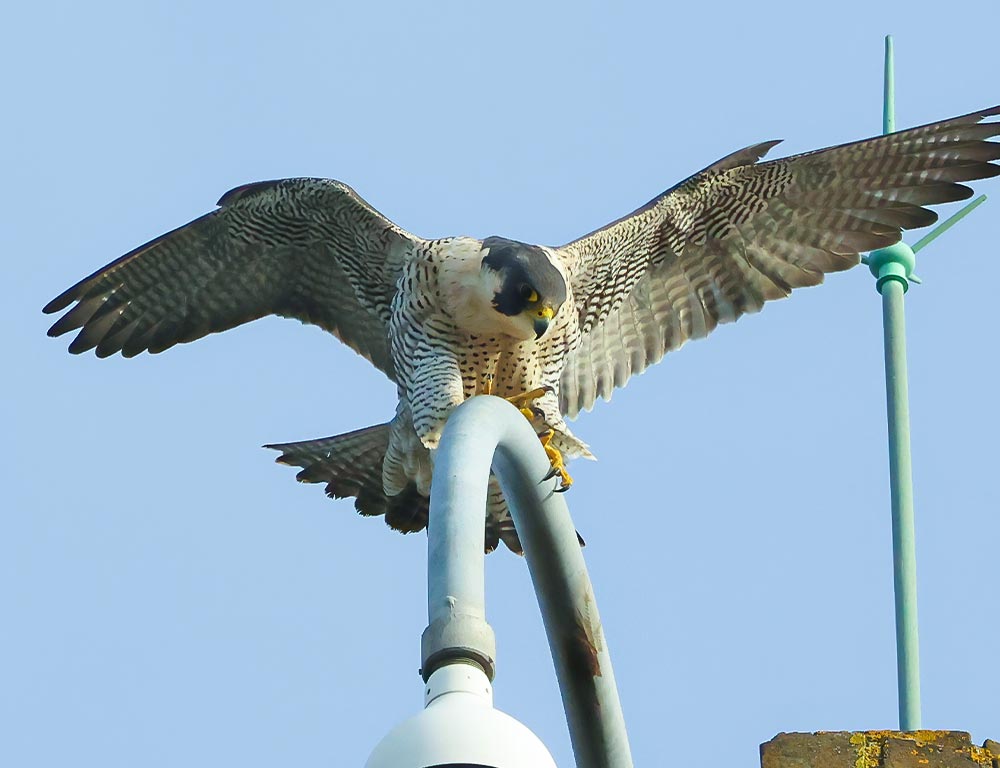
- Scientific Name: Falco peregrinus
- Life Span: 10-15 years
- Size: 15-20 inches
- Weight: 1.5-3.5 pounds
- Food: Primarily birds, often captured mid-air; occasionally bats and insects
- Wingspan: 3.3-3.6 feet
- Status: Least Concern (Global), Threatened (Eastern population in the U.S.)
With its powerful build and incredible speed, the Peregrine Falcon is an apex predator in Florida’s skies. These falcons exhibit an impressive lifestyle, adapted to various habitats, including coastal cliffs and urban structures.
Known for their exceptional aerial hunting skills, Peregrines achieve staggering speeds during high-altitude dives, reaching up to 240 mph while targeting avian prey mid-flight. Their diet primarily consists of birds such as shorebirds and pigeons.
Peregrine Falcons are territorial during the breeding season, establishing nests on cliffs or tall structures. Their breeding success is vital for conserving this species, especially considering their previous endangerment due to pesticide exposure.
Despite remarkable adaptability, the Eastern population of Peregrine Falcons faces ongoing threats, emphasizing the importance of continued conservation efforts to protect these majestic raptors and their diverse habitats.
2. American Kestrel
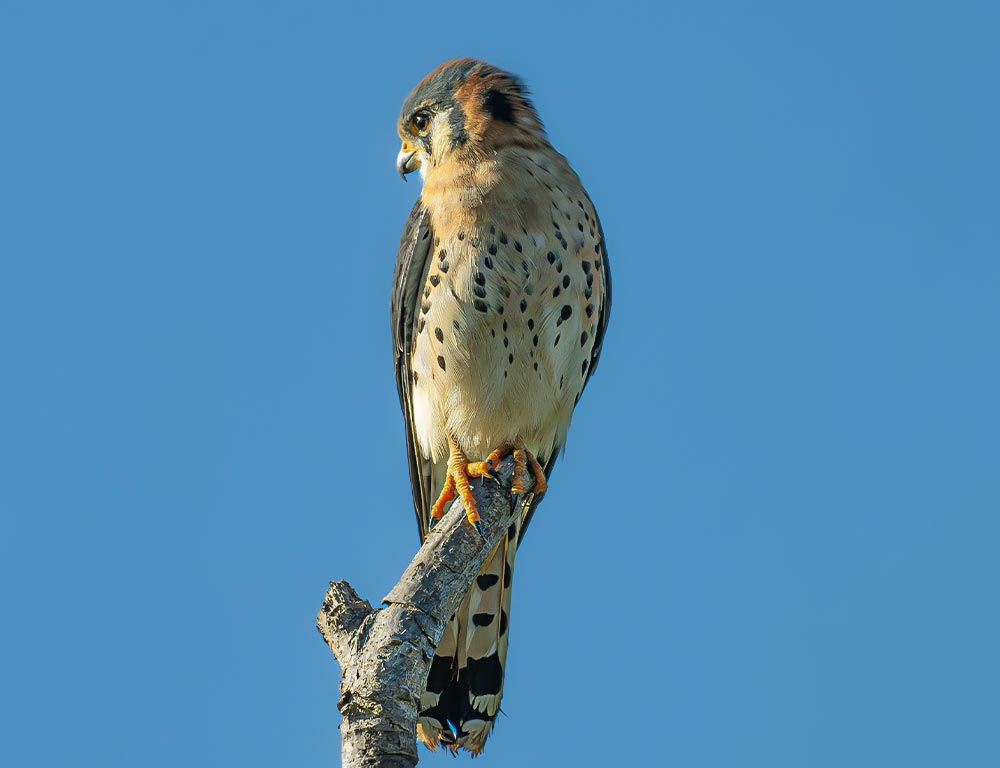
- Scientific Name: Falco sparverius
- Life Span: 5-10 years
- Size: 8-12 inches
- Weight: 3-6 ounces
- Food: Insects, small mammals, birds, and reptiles
- Wingspan: 20-24 inches
- Status: Least Concern
The American Kestrel, the smallest falcon in North America, brings a vibrant energy to Florida’s ecosystems.
With a diverse diet that includes insects, small mammals, and birds, these kestrels are highly adaptable. Their size and distinctive hovering hunting style make them a common sight in open landscapes, ranging from grasslands to urban areas.
American Kestrels often utilize natural cavities or abandoned nests for breeding. Their nests are well-crafted and may be found in tree hollows or on man-made structures.
Displaying sexual dimorphism, females are larger and exhibit striking rufous plumage. American Kestrels are known for their kee-kee-kee calls and are effective in pest control by controlling insect populations.
Although currently classified as Least Concern, ongoing habitat conservation efforts are crucial to sustaining their populations and promoting biodiversity in Florida’s dynamic environments.
3. Merlin
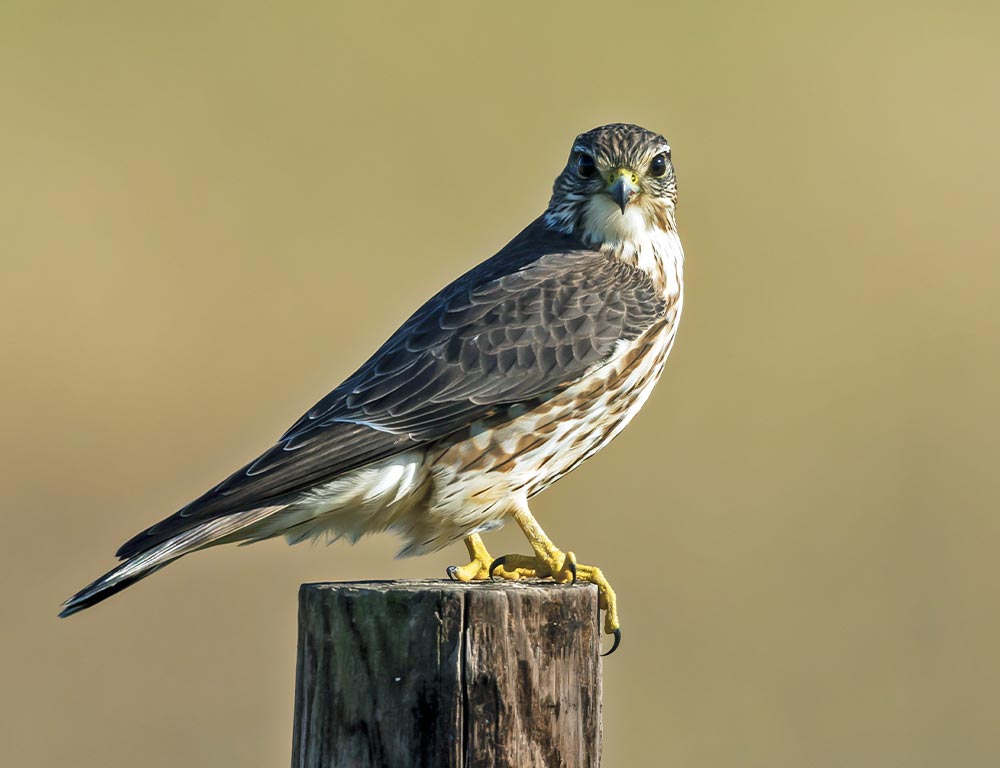
- Scientific Name: Falco columbarius
- Life Span: 5-10 years
- Size: 9-12 inches
- Weight: 5-8 ounces
- Food: Small birds, insects, occasionally small mammals
- Wingspan: 20-24 inches
- Status: Least Concern
The Merlin, a small and agile falcon, graces Florida’s landscapes with its swift and dynamic presence. With a diverse diet comprising small birds, insects, and occasionally small mammals, Merlins are adept hunters.
Their compact size and rapid flight make them efficient at chasing and capturing agile prey in open areas and woodlands.
Merlins often nest in coniferous or mixed forests, demonstrating flexibility in their habitat selection. During the breeding season, males engage in impressive aerial displays to attract mates. Their nests are typically built in trees or on ledges.
Merlins may travel vast distances between breeding and wintering grounds as a migratory species. While currently categorized as Least Concern, ongoing habitat conservation is essential to ensure the continued well-being of these captivating falcons in Florida.
4. Crested Caracara
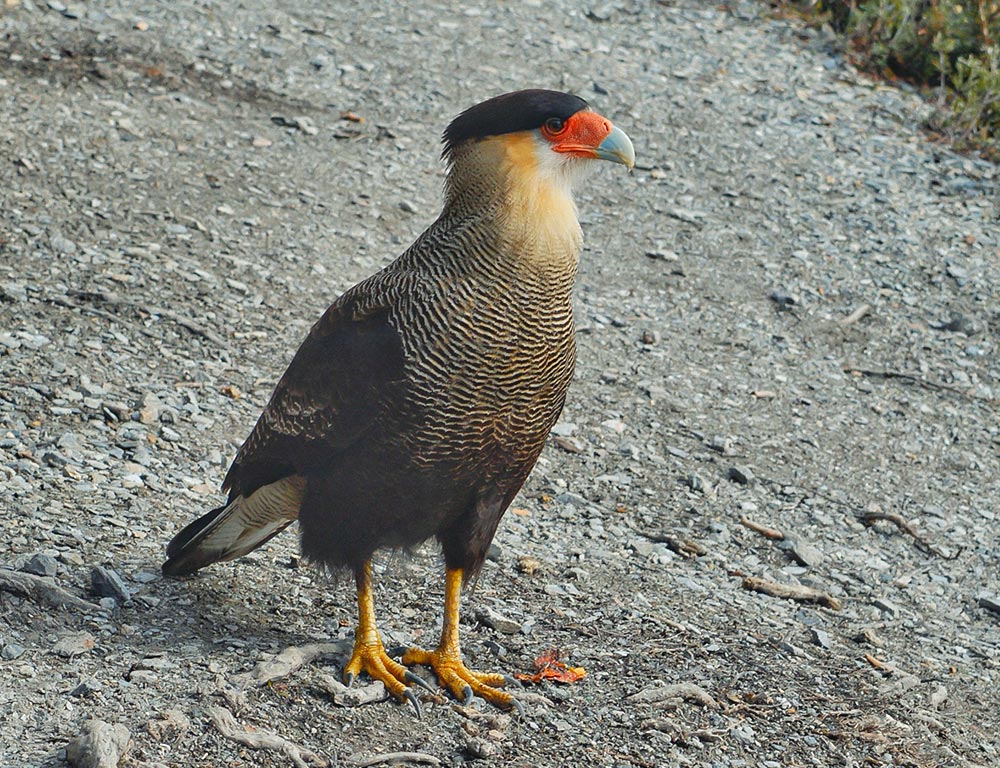
- Scientific Name: Caracara cheriway
- Life Span: 10-15 years
- Size: 19-23 inches
- Weight: 2-3.5 pounds
- Food: Opportunistic scavenger, feeds on carrion, small mammals, reptiles, and birds
- Wingspan: 4.5-4.9 feet
- Status: Least Concern
The Crested Caracara, a distinctive bird of prey, graces Florida’s open landscapes and agricultural areas. With its striking appearance and opportunistic feeding habits, this caracara stands out among raptors.
Often seen scavenging on carrion, the Crested Caracara also feeds on small mammals, reptiles, and birds, showcasing its versatility in food sources.
Crested Caracaras build nests on the ground or in low trees, often in areas with minimal human disturbance. Their nests are made of sticks and lined with various materials.
Known for their social behaviour, these caracaras may form loose colonies during the breeding season.
While their populations are currently stable, habitat preservation and management are crucial for sustaining their numbers and ensuring the continued presence of these charismatic birds in Florida’s diverse ecosystems.
Wrapping Up
Florida’s skies are enriched by the presence of diverse falcon species, each contributing to the intricate tapestry of the state’s ecosystems.
From the Peregrine Falcon’s high-speed pursuits to Merlin’s agile hunting and the Crested Caracara’s distinctive scavenging, these raptors showcase nature’s adaptability.
Understanding their lifestyles not only unveils the wonders of avian behaviour but also underscores the importance of conservation efforts to safeguard their habitats.
As these falcons navigate urbanization, changing climates, and potential threats, a collective commitment to preserving Florida’s natural spaces becomes paramount.
The coexistence of humans and these majestic birds relies on our understanding and protection, ensuring the continued presence of these aerial wonders in the Sunshine State’s dynamic landscapes.